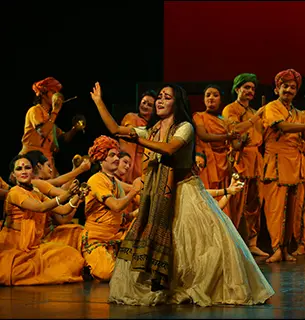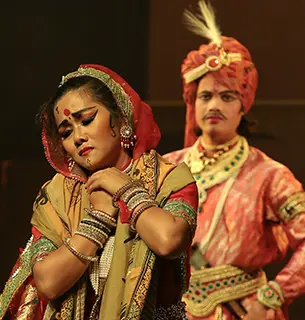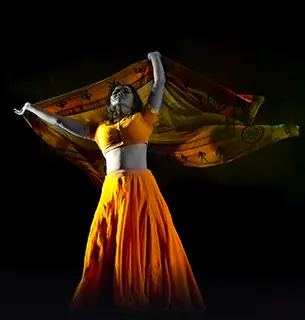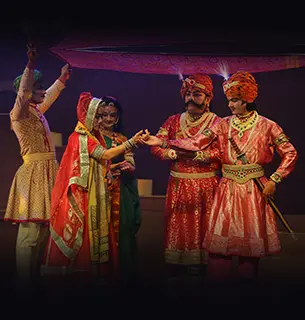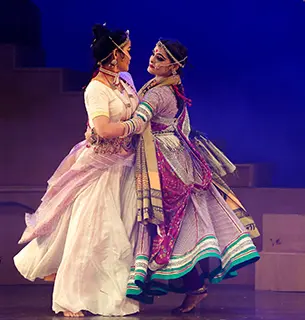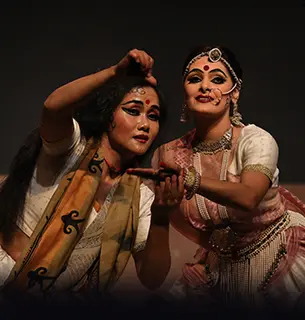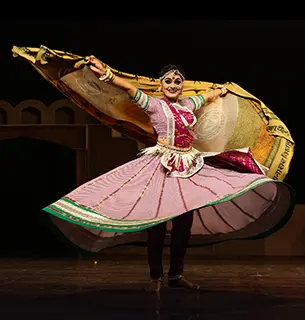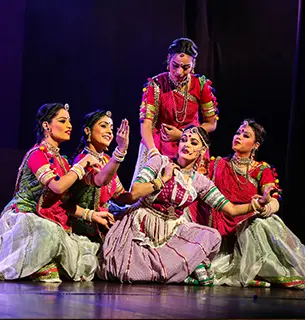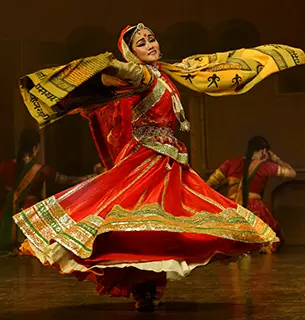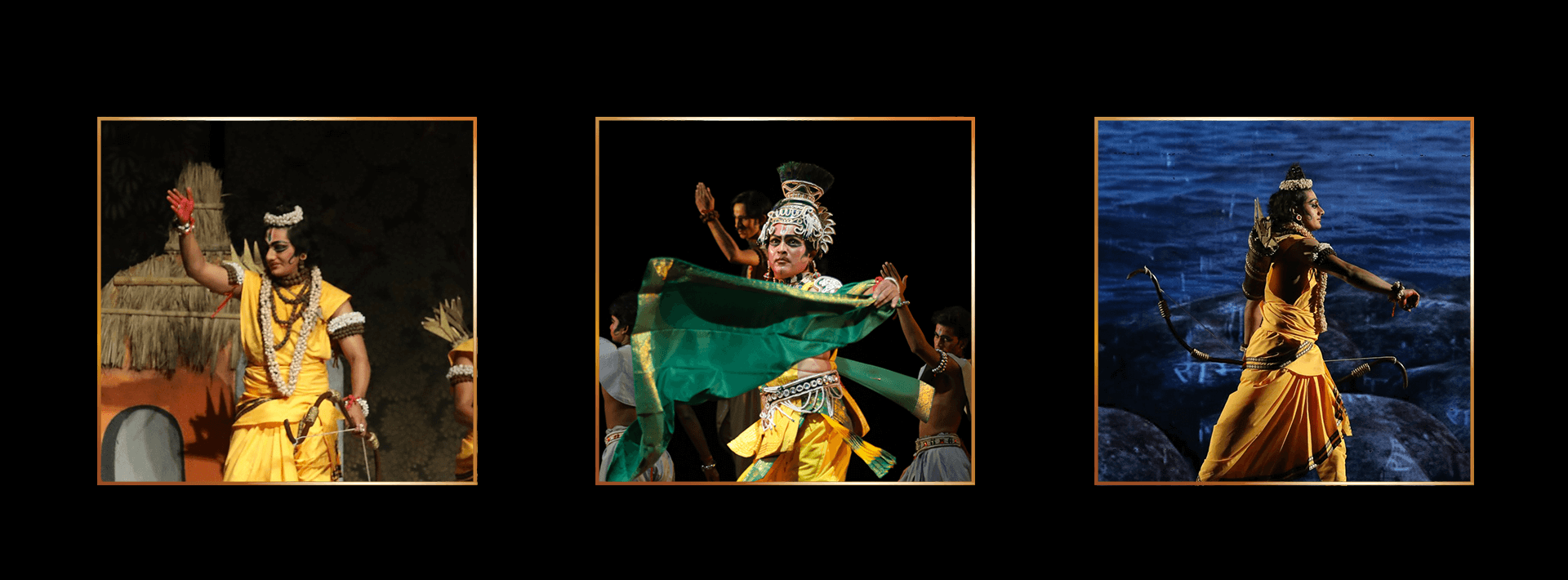
About Flagship Productions
The Kendra has ambitiously produced multiple dance-dramas over the years. These large-scale spectacles are based on Hindu mythology, Sanskrit and literary classics, historical characters, and varied contemporary themes.
The frontrunners of these memorable ballets are the Kendra’s flagship productions – Shri Ram, Shri Krishna, and Meera that are presented almost every year to date. The audience continues to marvel at these larger-than-life productions that explore and present Indian culture’s legendary epic and folk themes.
Shriram Bharatiya Kala Kendra’s charming edition of ‘Ramayan’ enables the audience to witness a perfect combination of a support system which works very well together with greatness and reality. This presentation is a collective of a beautiful fabric of choreography, dance, music, costumes, lighting et al.
The script was written by Hindi poet, Ramdhari Singh ‘Dinkar’, while Tapas Sen and Inder Razdan designed the set and the lights. Narendra Sharma and Jayanti Sharma were the principal actors. It was one of the first dance-dramas to be shot and relayed by Delhi Doordarshan. Shri Ram also weaves contemporary socio-political issues into the storyline of the epic of Ramayan.
This once-a-year production of Shri Ram began in 1957 and has since been staged every year, without fail, for about a month between Dussehra and Deepawali. It has become a popular event in the cultural calendar of New Delhi.
The Ramayan opens a door through the medium of a story to an inner world of a powerful truth which has motivated and guided Indians for periods of time in history. The theme possesses a togetherness of form and message which allows the story to penetrate logic and doubt that guard the inner life of the human soul. At every step along our way and whilst following the footsteps of Ram, we meet helpers and messengers of the Lord who show us the way just as Ram did during his exile. For just as Ahilya met Ram, so does each one of us (come face-to-face with the Ram within us).
As the story discloses the difficulties of a human, the feelings of love, hate, fear, etc. and situations of the time, it is then that the Ramayan unfolds deep layers in terms of wide-ranging aspects of the human character. Outcomes of the reflections and responses of the narration remain evergreen and never-ending, as they do even in modern day’s experiences, sufferings, and conflicts of the mind and heart.
The epic tale of Lord Ram presents a combination of core values that display feelings of loyalty, love, hate, fear, and respect to the elders even in tough family relationships. The Kendra’s ‘Ramayan’ absorbs us in the basic thinking that offers an opportunity to lead a socially healthy, good, and harmonious lifestyle. It also guides us in the way of thinking the basic truth, and the rules of an entertaining avatar. The Kendra’s presentation illustrates important and fascinating events from the famous Ramayan. The showing of the greatly respected ‘Ram’, his preference for being in exile, Sita’s constant faith and love, even though there was an existence of personal troubles, the devilish Ravan and a few other events remain important, long after the curtain falls.
The duration of the dance-drama on ‘Lord Ram’, from his birth to his Rajya Abhishek, is 2:20 hours. The performances usually begin on the first Navratri, at the Kendra Lawns at 1, Copernicus Marg, New Delhi and continue till Dhanteras. Over the past 66 years, this production has travelled to 35 countries and is regularly performed in India.
This grand production, based on the life of ‘Lord Ram’, has been admired as an outstanding work in Yogyakarta, Indonesia, where they have a rich tradition of Ramayan performances.
It may be added that in the year 2018, the Ayodhya Shodh Sansthan of the Government of Uttar Pradesh gave a special honour to the Kendra for having produced one of the best international presentations of Ramayan. As a part of the annual Diwali celebrations (Deepotsav), we were invited to Ayodhya, Uttar Pradesh to perform for the audience. The Chief Minister of Uttar Pradesh, Yogi Adityanath, and other government officials were completely enchanted by our show.
The Kendra’s Ramayan is excellent in more ways than one. We have had the rare privilege of our production being witnessed by almost all Indian Presidents and Prime Ministers to date. The Kendra’s copy of the Ramayan itself is unique for it carries the signatures of all the past Presidents and Prime Ministers.
The initial aid which started off Kendra’s ‘Ramayan’ was provided by the then Prime Minister, Pt. Jawaharlal Nehru, and was carried forward by several patrons, including the then Chief Minister of New Delhi, Smt. Sheila Dixit, who patronised the production during her tenure. Sh. Atal Bihari Vajpayee and Sh. Lal Kishan Advani, in an official capacity, were regular audiences who saw the show almost every year.
This “sampoorna Ramayan” is one of its only kind ever produced in the history of Indian culture with original music, dances, costumes, jewellery, sets etc. The show is performed by our skilled performers who are trained and developed in-house.
Popular than any other international show in the world, this production prides itself in having physical footfalls of over 7.0 lac viewers spanning 66 years in existence. It is to be noted that various cycles of human generations have evolved with this production.
It is always special to see Lord Krishna Janmashtami images or directly watch SBKK’s Shri Krishna drama production, a spectacle in itself.
Meera Bai ke pad are revered and known to be pure and precious, just like her devotion to Lord Krishna. This is why SBKK’s Meera dance-drama is well-enjoyed and much-appreciated by one and all, based on Meera Bai’s teachings and her inspirational life.
The Ramayan drama is wonderful to watch, especially Ramayan in Hindi and for those who appreciate Aarti Shri Ramayan ji ki. The Ramayan show is an extravagant dance-drama that includes Ramayan chaupai in Hindi.
This dance-drama depicts Krishna’s life from his birth to his liberation.
For over three thousand years, Krishna’s fascinating personality, which is visible in the original Mahabharat, has been enveloped in tales, myths, miracles, and love. He was wise and heroic, loving and loved, foresightful yet present, blessed with sage-like detachment yet deeply human, the diplomat, the sage, and the man of action with a personality as dazzling as that of the Divine.
Because findings show that Mahabharat’s Krishna and the butter-stealing Krishna are two different characters who have blended over time, the ballet presents Krishna’s two different personalities in completely opposite ways. The play’s first half is devoted to famous stories like ‘Makhan Chori’, ‘Govardhan’, ‘Kaliya Raas’, and others. In this production, the status of women has been given a new meaning. ‘Krishna’ raises the position of ‘Radha’ from that of a lover to being his “divine consort”. The story of the Yadavas is linked with that of Krishna Vasudeva, whose uncle Kansa tries to kill him but he overcomes and the lengthy fight with Magadha’s Jarasandha pushes Krishna and the Yadavas to leave Mathura and go to Dwarka.
The ‘Chakradhari Krishna’ of the second half has been described as the one who despite having leadership skills, becomes subject to divine foolishness. This act is based on lesser-known Mahabharat stories. There has been a single-minded effort to break out from the rut of mindless faith and raise concerns of importance. With this clear aim, the plot’s second half deals with situations that bring up several timeless and everlasting topics for dialogue.
The tales in the dance-drama describe a folk hero who was extremely impressive and courageous in confronting the crisis faced by a rural community. This includes threats from the animals of the forest to the herds and shepherds. Krishna was looked up to as a leader in his lifetime and later worshipped as God. Yet, in the Mahabharat, the message of the Bhagavad Gita is the key. The author, Ved Vyas, develops the combination of Krishna the charioteer and Arjun the rider, softly connecting the same with the mind and body. When Krishna asks Arjun to consider all he has taught, he says, “We yet again see them as ideal forms of knowledge and conduct; where they rise above history to make destiny themselves.”
While Krishna separates himself and sets himself against his relatives in the Mahabharat, he is caught in an expanse of difficulties. The story is packed with violence but it is the approach in which the story finds peace without fighting back that is important. On the same battlefield, solutions to the bloodshed are being offered. The Kurukshetra War has survived all through the generations, and the message of victory and forgiveness is more significant today than ever before.
Performed religiously during Janmashtami, the production shares the space with ‘Shri Ram’ as another flagship production of Shriram Bharatiya Kala Kendra. Throughout its 50-year life, this dance-drama has grown from a simple story about Lord Krishna to personal difficulties and solutions relevant to modern society. Several dignitaries have attended the productions which have moved around India and the world.
This Lord Krishna version is one-of-a-kind in Indian cultural history, with original music, dances, costumes, jewellery, sets, and more. The show is performed by our in-house trained and developed artists.
Meera is one of our country’s greatest saint poetesses. She illuminated an otherwise infertile desert with her poetry and educated millions of people seeking “different” paths. Her talent comes in her ability to spread, almost engagingly, the struggle in her life through her poetry. Meera challenged the patriarchal order, and that challenge is as strong today as it was during her lifetime. Meera travelled wherever she wanted, spreading the message of freedom and promising an inner awakening through the energy of her poetry.
Her poetry is soaked in the blood of situations that bear witness to what she, as a symbol for women, had to endure. Meera was not attracted to materialism. She discovered that the image of the Lord was her metaphor for the desire for deeper enlightenment. Meera left behind all the riches and comforts befitting a princess. She succeeded by breaking down the boundaries of tradition and custom. The stone walls collapsed down, the iron bars of her jail melted away, the royal tradition was broken, and a freed Meera emerged – her dancing and singing signifying feminine abandon.
Meera is the main point for artistic expression because she escaped the patriarchal rule and hierarchical control many years ago. The challenge of creating a dance-drama based on Meera’s life emerged from a wealth of information that brought up a multitude of options on how to interpret this lone crusader’s life. Meera continued her journey, accepting liberties and inspiring others.
Her songs continue to reach those who have been damaged and humiliated, and who see in them a message of liberation. Meera’s image has been redefined in this dance-drama. It examines the condition of Indian women seeking space in a male-dominated society.
For that purpose, the Kendra has attempted to keep the production values as authentic as possible. The choreography is based on the rich Rajasthani dance culture and takes into account Meera’s continuous evolution throughout the years. Komal Kothari provided a variety of material for the songs. The narrative unfolds through dance and song, transforming Meera into a passionate missionary.
While Meera appeared to provide no creative difficulty at first, by the end of the research that Shubha Mudgal, Jayamala Aiyer, Keshav Kothari, and Shobha Deepak Singh conducted, they were certain that the miracles in Meera’s life were allegories of the challenges that women face.

















